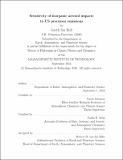| dc.contributor.advisor | Susan Solomon and Noelle E. Selin. | en_US |
| dc.contributor.author | Holt, Jareth (Jareth Ian) | en_US |
| dc.contributor.other | Massachusetts Institute of Technology. Department of Earth, Atmospheric, and Planetary Sciences. | en_US |
| dc.date.accessioned | 2017-02-22T15:59:49Z | |
| dc.date.available | 2017-02-22T15:59:49Z | |
| dc.date.copyright | 2016 | en_US |
| dc.date.issued | 2016 | en_US |
| dc.identifier.uri | http://hdl.handle.net/1721.1/107032 | |
| dc.description | Thesis: Ph. D. in Climate Physics and Chemistry, Massachusetts Institute of Technology, Department of Earth, Atmospheric, and Planetary Sciences, 2016. | en_US |
| dc.description | This electronic version was submitted by the student author. The certified thesis is available in the Institute Archives and Special Collections. | en_US |
| dc.description | Cataloged from student-submitted PDF version of thesis. | en_US |
| dc.description | Includes bibliographical references (pages 97-111). | en_US |
| dc.description.abstract | I present work on the relationship between inorganic atmospheric aerosol impacts and their precursor emissions from the United States of America. The inorganic aerosol ions nitrate (NO--₃), sulfate (SO²-- 4 ), and ammonium (NH+4 ) form from emissions of nitrogen oxides (NOx), sulfur dioxide (SO₂), and ammonia (NH₃). Emissions of NOx and SO₂ in the US have recently decreased, by 42% and 62% respectively for annual totals between 2005 and 2012, in response to economic, political, and technological developments. Under such large changes, the processes of aerosol formation may behave nonlinearly. The sensitivity of aerosol impacts to future emissions reductions -- the change in a metric per unit change in emissions -- can be very different from the sensitivity to past reductions. In this thesis, I use a chemical transport model to examine the sensitivities, changes in sensitivities, and the importance of nonlinear interactions for both health and climate impacts of inorganic aerosols. The first section of this thesis focuses on surface concentrations of inorganic fine particulate matter (PM₂.₅), a relevant metric for human health. In winter, PM₂.₅ across the central US is primarily composed of ammonium nitrate, whose formation is highly dependent on thermodynamics. The recent NOx and associated total nitrate (HNO₃+NO--₃ ) reductions have made aerosol formation in this region limited by total nitrate availability. Future NOx emissions reductions will thus have a much larger impact than they would have in the past. In summer, SO²-- ₄ aerosols dominate PM₂.₅. The reduced NOx emissions lead to higher peroxide concentrations and faster aqueous SO₂ oxidation, without increasing sulfate wet deposition to the same degree. With faster oxidation, a larger fraction of the emitted SO₂ forms sulfate and particulate matter, increasing the sensitivity of surface aerosol concentrations to SO2 emissions even as emissions themselves have decreased. These results suggest that NOx and SO₂ emissions reductions will continue to improve US air quality. The second section of this thesis focuses on sensitivities of the direct radiative effect (DRE) of inorganic aerosols to US emissions, a key quantity for studying climate impacts. The DRE and changes in DRE in winter are largest over the ocean. The summertime DRE includes a long tongue of advected aerosols over the Atlantic as well as a broad area of large DRE over the eastern US. As with surface concentrations, sensitivity of DRE to NOx and SO₂ emissions increased between 2005 and 2012, while sensitivity to NH3 emissions decreased. A simple scaling estimate of the DRE in the 2012 case from the 2005 DRE and sensitivities overestimates the magnitude of the DRE by 10.3mWm-² in January and 21.4mWm-2 in July. These values are equivalent to underestimating the SO₂ emissions reductions by 13.6% and 10.6%, respectively. These processes cause small errors for climate studies that assume scaling of aerosol radiative effects for current conditions, but greater errors could occur under future emission changes. | en_US |
| dc.description.statementofresponsibility | by Jareth Ian Holt. | en_US |
| dc.format.extent | 111 pages | en_US |
| dc.language.iso | eng | en_US |
| dc.publisher | Massachusetts Institute of Technology | en_US |
| dc.rights | MIT theses are protected by copyright. They may be viewed, downloaded, or printed from this source but further reproduction or distribution in any format is prohibited without written permission. | en_US |
| dc.rights.uri | http://dspace.mit.edu/handle/1721.1/7582 | en_US |
| dc.subject | Earth, Atmospheric, and Planetary Sciences. | en_US |
| dc.title | Sensitivity of inorganic aerosol impacts to US precursor emissions | en_US |
| dc.type | Thesis | en_US |
| dc.description.degree | Ph. D. in Climate Physics and Chemistry | en_US |
| dc.contributor.department | Massachusetts Institute of Technology. Department of Earth, Atmospheric, and Planetary Sciences | |
| dc.identifier.oclc | 971494074 | en_US |
